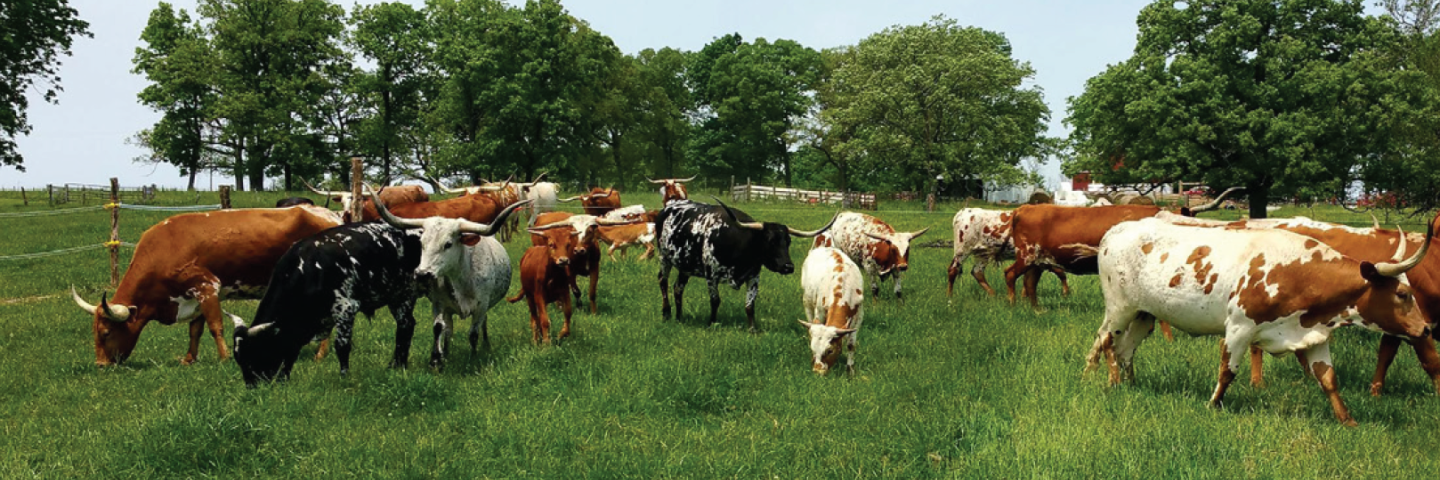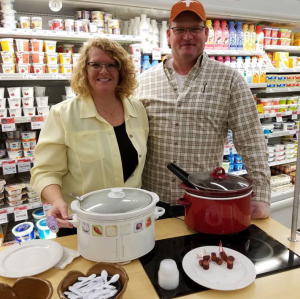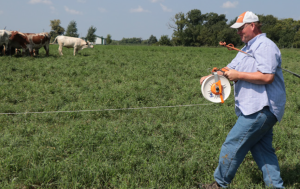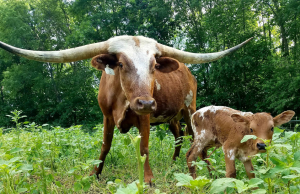
Longhorn Beef Packed and On Ice? That’s Neice!
Jeff Neice
Double J Pastures
Knox County, IL
Jeff Neice grew up in Alexis, Illinois. He’s been driving trucks as a private trucking owner/operator since he was 21. He was an over-the-road trucker who hauled meat until 2016 when he began hauling grain locally. It was about then he decided to pursue another line of work in his ‘extra time.’ Jeff’s brother-in-law runs a 100-head Longhorn beef cattle operation in Virginia. He feeds his herds corn and grains and breeds for color and width of the horns, which can be quite profitable. Jeff decided he wanted to become a first-generation farmer and decided to get into livestock himself. He too, liked Longhorns but was never that impressed with the horns themselves. He wanted to do Longhorns, but he was in it for the MEAT.

In 2015 Jeff and wife Jennifer bought 15-20 cows from his in-law’s herd along with one bull and introduced them to life in Illinois. Jeff originally established his cattle business on 15 acres in Stark County but soon realized a need to grow and had the opportunity to do that in Knox County. He still keeps some cattle in Stark; however, the main herd lives on 82 acres in Knox. That land was cropped previously but Jeff was ready to convert it and start growing quality, lush grazing grass on those acres.
Going “All In”
Jeff is the type of guy who takes on tasks and challenges at full speed. He approaches life with energy, enthusiasm, and high expectations. When he decides to do something, he does it right and the best way he possibly can. What did Jeff have in mind for HIS Illinois Longhorn cattle operation? Something completely different.
Jeff liked Longhorn cattle as a breed but had little interest in breeding, marketing, or selling the horns. To Jeff, the quality and characteristics of the meat itself is what was above average. But he felt the breed itself was too large to manage easily, in addition to the extra challenge of negotiating wide and dangerous horns.
To execute his plan, Jeff had to do three things:
1. Start breeding his Longhorns with Aberdeen Angus—genetically bring frame size down (< 1,000 pounds) and increase calf-weaning time to 10 months.
2. Begin growing quality rotational grazing pastures on his new acres.
3. Market and sell his ‘unique’ local meat products for the best price possible.
Jeff continues to drive his truck for a steady income as his livestock operation becomes more profitable. His new local routes give him more time for managing herds. “I knew it would take time to get things in place and to make all the changes I wanted,” says Jeff. It was both challenging as well as expensive.
New Friends at NRCS

That’s why Jeff contacted friends and local technical staff at USDA’s Natural Resources Conservation Service (NRCS) in Galesburg, IL. They collaborated with Jeff over his plans, discussed operational details, and decided how NRCS’s technical information, conservation practices, and financial assistance programs could help turn Jeff’s plans into a reality. “I got lucky when I hooked up with District Conservationist Cathy Froelich and Natural Resource Specialist Matt Bunger. They both went above and beyond what I could have asked for,” Jeff says.
As he sees it, Neice entered the livestock business from the outside. He brought no preconceptions or bad habits. “Most livestock operators I’ve seen just keep doing the same things they’ve always done. I wanted to think this through, do it right, even do something different,” he says.
“I figured that nature has a pretty good playbook for growing healthy cows. My plan was to use rotational grazing concepts and take advantage of NRCS programs available to new farmers like myself,” Jeff explains.
NRCS staff evaluated the land Jeff bought in 2015 and together they devised a plan of action, including a list of natural resource concerns that needed to be addressed. The Environmental Quality Incentives Program, EQIP, helps livestock owners fix problems and pays part of the cost for engineering designs, materials, and construction of conservation practices selected. Here’s what Jeff needed and what EQIP helped pay for:
- 13,100’ of fencing, gates
- Well for centralized water facility
- Pumping plant
- 6,665’ of pipeline for water facilities
- Grass species for pasture planting on 3.5 acres
- 45.3 acres of Prescribed Grazing
- Rotational Grazing Plan
- 1,300’ of Access Road
- 12,768 sq/ft of Heavy Use Area
- Eight 2-hole frost-free fountains
- Winter Feeding Station
- 5,125’ Trail and Walkway
“Jeff and Jennifer are both motivated and great to work with,” says Froelich. “Unlike some EQIP contract holders, Jeff was more than ready to get everything in his plan built, installed, and up and running. He began in November 2016 and hasn’t looked back.” Jeff built several EQIP practices in 2016 and 2017, but for some, he was glad to take more time. Waiting let him properly tweak specific elements of his grazing system as things all came together.
The Winter Feeding Station (WFS) has been invaluable during harsh winter weather. When pastures ice over from snow and rain, the WFS serves as a dry, clean place to feed hay, as well as when the frost comes out of the ground in the Spring. Otherwise, the cattle use pastures to their full extent, taking advantage of stockpiled forage. The longer the cattle stay on the pastures, the less manure there is to haul. With Jeff’s Longhorns, he designed special hay racks inside that accommodate the horns on his specific breed. Jeff also lets cows and calves take advantage of WFS shade during extreme summertime heat, along with dry loafing areas during wet, seasonal rains.
Learning Curve
On his “near but not certified” organic operation, Jeff never uses chemicals detrimental to bees. A friend of his was looking for diverse and exceptional hive locations away from risks from pesticide use and drift. Jeff loves bees but didn’t have time to do it himself, so they cut a deal and established four beehives on two pasture locations. The bees use Jeff’s seeding for nectar production. Jeff also has plans to plant more pollinator-friendly fruit-bearing trees on his acreage in the future.
“I’m learning a lot. I’ve learned to adapt my thinking and my methods. I’m becoming a better observer. I look carefully at all my grass, the actual plants, their color. I watch what my cows eat first and what they don’t eat. I learn something new every day,” says Jeff. Neice named his Knoxville farm “Double J Pastures” after Jeff and wife, Jennifer.
According to Jeff, when it comes to managing pastures, “I think it’s more important what you leave in that pasture than what you let the herd take off.” That is a key lesson all graziers must learn and carefully monitor. Jeff and Jennifer both look after all members of the herd with passion and conviction. They even name special cows and bulls and have been known to put a sick calf in the back of Jeff’s truck to run it over to the vet.
Neice created nine paddocks on his non-timbered 45 acres and then further subdivided those. These days, he breeds about 25 cows using three bulls. With his local day job, he’s able to move his cows twice daily. Jeff placed quick connect hydrants every 200 feet to correspond with moving temporary fences twice daily and providing needed water for his cattle. These tools offer flexibility for his intensive and high-density grazing system.
Jeff’s brother still thinks he’s crazy to move fences and cows in and out every day. Jeff smiles because his herds are happy to move onto fresh grass. “It only takes a few minutes to do it,” he ways. “Well, usually. That’s one of the things cows will teach you—patience!”
According to Jeff, “Working with NRCS and the EQIP program allowed me to address the need for water, winter feeding, and grazing distribution by means of fencing. The fence allows me to better manage the forage, which gives me more diverse forage, less problem weeds and reduces grazing time. That helps me meet market demands better.”
Innovation is Required
Jeff uses several innovative ideas on his farm. Last winter he frost-seeded clover and annual ryegrass as a cover crop on 12 acres. He’s found compaction problems on some soils and read that two seasons of annual ryegrass does the same job as a deep ripper—without all the erosion. He hopes those deep roots and soil biology start breaking things up. In early April he saw all the rye coming up. Cover crops are an important part of Jeff’s commitment to maintaining good soil health beneath all his pastures. He manages his cows grazing regimen based on the height and needs of the grass and the soil. When the pastures are healthy and lush, his herds are as well. It’s an easy concept, even for a new farmer.
Jeff constructed his “pasture buggy,” a mobile cart that offers mineral feeds on the front, a dry hay feeder in the middle, and a water tank on the back. He moves the buggy to where his herd is grazing; they always have all they need.
“Sometimes I think we humans tend to over-complicate things in agriculture. Simple is always better,” says Jeff. He enjoys what he’s doing and learning on the farm. He applies himself and his mind to constantly make the system work even better.
When it comes to weeds, Double J takes a 2-prong approach. The first line of defense is their small herd of goats and the second is mowing. A couple times per year, after grazing a section of pasture with the cows, he mows the pasture and bales excess forages for hay. This keeps the weeds the cattle find less desirable from going to seed. According to Jeff, “This is how I manage weeds without using herbicides.”
Matt Bunger, NRCS Natural Resource Specialist explains, “Leaving more forage in the pastures provides Jeff a better canopy where fewer weeds can grow. If cattle graze too close, it opens the ground for increased weed germination and growth. You’ll always have some weeds in pasture, but we must ask ourselves, ‘what is a weed?’ Many plants we call weeds are actually very nutritious to livestock. They can increase pasture diversity and improve pasture health.” Increasing livestock density plays a critical role in controlling weeds as well, by forcing animals to eat the weeds versus avoiding them.
“From what I’ve observed of Jeff’s grazing management, his weed problem is minimal. There will always be some species livestock will avoid. He uses goats or mechanical treatment to take care of those,” Bunger adds.
Finding New Markets
Some folks doubted Jeff could raise good beef on grass alone or that he could sell his Texas-style beef here in the Prairie State. But don’t ever tell Jeff he can’t do something. He’ll prove you wrong. Double J Pastures Gourmet Grass-Fed Beef is doing pretty good for a new operation. Perhaps it’s due to Jeff’s sociable personality or his hard-working nature. Maybe it’s his marketing and customer education using gorgeous photos and write-ups about how he manages his operation using Face Book posts. Whatever he’s doing is working. Interest and demand in his Longhorn beef has been surprising.
Double J sells gourmet grass-fed beef at the Galesburg Farmers Market and at the Sheridan Village HyVee grocery in Peoria, Illinois. Products include filet mignon, New York strip and ribeye steaks, chuck roast and beef brisket as well as a Sampler Pack with ground beef, snack sticks, cured bacon, bratwurst, wieners, and sausage. Based on Face Book posts, customers are impressed with his cows, his management and stewardship, and his delicious meat products.
Neice recently hooked up with a vendor who needed local meat for a pet food company making high-end raw pet food. “Consumer tastes and demands are changing,” Jeff says with a wide grin. “There’s money to be made if you find that niche market and consistently deliver quality goods. Things are good now, but they’re getting even better. Is it profitable right now? It will be.”
And yes, in addition to all the delicious and marbled lunchmeats and steaks, he’s also selling some horn mounts from his Longhorn cattle for a pretty sweet price. “Plus, I told my brother-in-law that my little operation here in Illinois is just as popular as his. I’ve got cars stopping on the road just to take pictures of my cows lounging out in the pastures,” Jeff adds.
Characteristics of Long Horn Cattle

- Heat-tolerant
- Simple genetics
- Good “Mom” cows
- Disease-resistant
- Quality meat (low calorie/low fat)
- Efficient foragers
- Valuable horns
- They’re simply different; people stop all day to look at them...which is good for marketing!
To learn more about conservation solutions NRCS and EQIP can put on YOUR farm or livestock operation, call NRCS today or visit Illinois NRCS.

